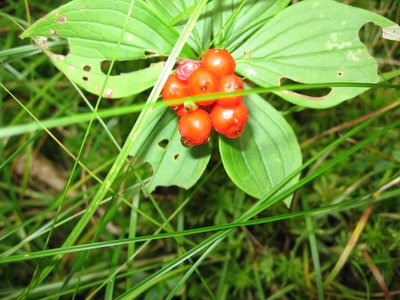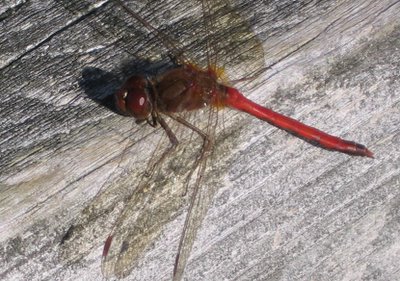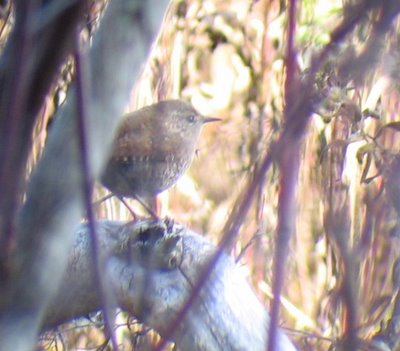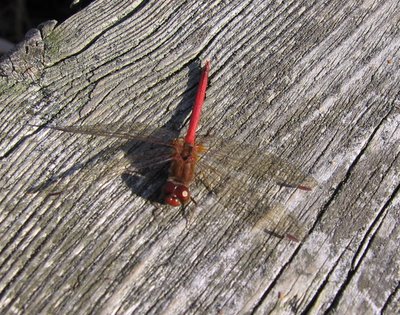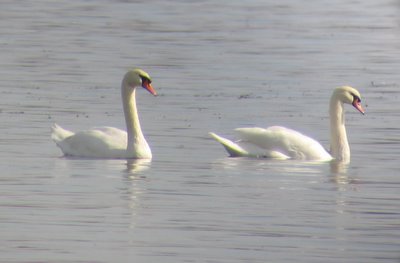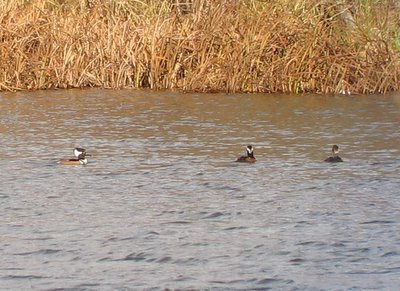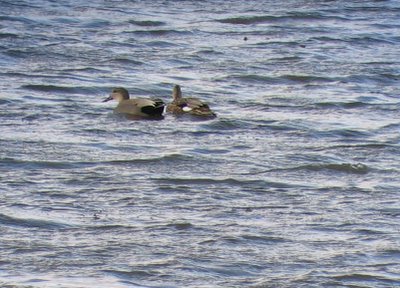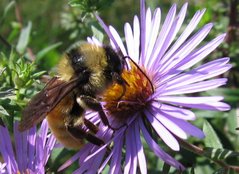Sunday, December 25, 2005
Monday, December 19, 2005
Amherst Island, Ontario
 We saw four different Snowy Owls on the Island today.
We saw four different Snowy Owls on the Island today.They were easy to spot on their prominent perches.
We were surprised to see several of these as they aren't
a winter bird here.
a winter bird here.
All of the above birds were seen while driving around the island. We walked into Owl Woods but for all the trudging through the snow we only saw one Long Eared Owl. We had hoped for Northern Saw-whet and Boreal but no luck.
Thursday, December 15, 2005
A Winter's Day at the Point
Sunday, December 11, 2005
Winter at the Point
Tuesday, December 06, 2005
St. John's Wort

I took this picture at the beginning of August this year. I found this plant growing in a sunny, open field. I have yet to find anything like it on the internet or in my guides. The search continues. I plan to keep posting and trying to identify pictures of plants that I took throughout the year last year. I also intend to post more current pictures but between work and being sick I haven't been out for a while. I'm hoping for an opportunity this weekend.
Thanks to Nathan for identifying this as St. John's Wort. I found a good resource at the Plants Database of the USDA (I'll put a link in my links section).
Sunday, December 04, 2005
Bur Marigold
Friday, December 02, 2005
New England Aster
September 19, 2005
Picture taken in the dragonfly field at Lemoine Point, Kingston, Ontario.
Picture taken in the dragonfly field at Lemoine Point, Kingston, Ontario.
Tuesday, November 29, 2005
Lots of Deer at the Point
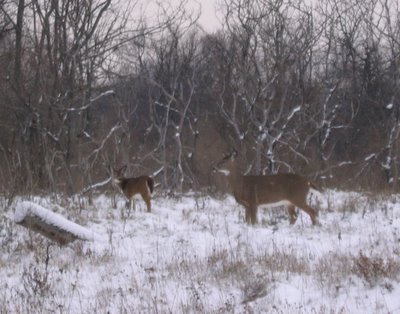

There is something about the snow and the bare branches and the grey skies that make the animals less nervous. I was able to walk up quite close to the Barred Owl and to these deer. They never did run off, even when I came near and after I turned and walked away. I had no need of a spotting scope today. All that was required was that I walk slowly, pausing regularly to let them get used to me.
Sunday, November 27, 2005
A study in grey

If gulls are a study in black and white then owls are a study in grey. Close up you can see the browns and whites of the Barred Owl but from a distance, when you first spot them, they are just a big grey blob. Everything was one shade of grey or another today. Even though it was the middle of the afternoon when I went over to the Point the sky was so heavy with clouds that it seemed like dusk. The trees were all grey branches, the sky was grey, and even the mood was a subdued grey as I walked about in the silence of the snowed landscape. This was the first Barred Owl that I have seen at the Point and the second one that I have seen in my lifetime (the other was on Amherst Island earlier this fall). Birds can be difficult to spot at the best of times. Most often it is movement that attracts our attention and then we can pick them up with the binoculars. Spotting an owl that is stationary and that blends in so neatly with its background is more difficult. What you are looking for is not an owl but a shape. You look for something that doesn't fit in with the skeleton of the tree and its bare branches. I'm not surprised that I saw another Barred Owl so soon after I saw my first one. I remember Pamela over at Thomasburg Walks commenting that once you've seen a species for the first time you begin to see them again and again. You get an eye for them and the mind remembers certain connections. This is one bird that I hope will keep coming up because it is a truly noble sight as it surveys its hunting grounds with "owlish solemnity."
Bunchberry
Algonquin Provincial Park, Ontario
August 10, 2005
If you come to Algonquin in June you'll find this common plant in beautiful white flower but by summer the flower is gone and these red berries take their place. The booklet "Wildflowers of Algonquin Park" explains that this plant is a member of the dogwood family. Many of these plants are connected by roots that are parts of one larger plant that may cover many square metres.
August 10, 2005
If you come to Algonquin in June you'll find this common plant in beautiful white flower but by summer the flower is gone and these red berries take their place. The booklet "Wildflowers of Algonquin Park" explains that this plant is a member of the dogwood family. Many of these plants are connected by roots that are parts of one larger plant that may cover many square metres.
Friday, November 25, 2005
Flowering Dogwood
Presquile Provincial Park, Brighton, Ontario
September 8, 2005
Although common in the U.S. this tree occurs only in the extreme south of Ontario. The USDA Forest Service website says this about the importance of Dogwood to wildlife:
"Flowering dogwoods are extremely valuable for wildlife because the seed, fruit, flowers, twigs, bark, and leaves are utilized as food by various animals. The most distinguishing quality of dogwood is its high calcium and fat content (5). Fruits have been recorded as food eaten by at least 36 species of birds, including ruffed grouse, bob-white quail, and wild turkey. Chipmunks, foxes, skunks, rabbits, deer, beaver, black bears, and squirrels, in addition to other mammals, also eat dogwood fruits. Foliage and twigs are browsed heavily by deer and rabbits."
September 8, 2005
Although common in the U.S. this tree occurs only in the extreme south of Ontario. The USDA Forest Service website says this about the importance of Dogwood to wildlife:
"Flowering dogwoods are extremely valuable for wildlife because the seed, fruit, flowers, twigs, bark, and leaves are utilized as food by various animals. The most distinguishing quality of dogwood is its high calcium and fat content (5). Fruits have been recorded as food eaten by at least 36 species of birds, including ruffed grouse, bob-white quail, and wild turkey. Chipmunks, foxes, skunks, rabbits, deer, beaver, black bears, and squirrels, in addition to other mammals, also eat dogwood fruits. Foliage and twigs are browsed heavily by deer and rabbits."
Tuesday, November 22, 2005
Fireweed
 Algonquin Provincial Park, Ontario
Algonquin Provincial Park, OntarioAugust 10, 2005
This colourful weed occurs throughout North America and Asia and is the national flower of Russia (One person's weed is another person's flower). It grows prolifically in areas that have been disturbed either by people or by nature. I found this one (in the company of many others) along Highway 60 in Algonquin Park.
Pileated Woodpecker
I wanted to post this picture of the Pileated that I saw last Thursday. This was the first time all fall that I didn't have the scope with me. I could have taken some good shots as he stayed on this branch for quite a while. This was the best I could get with the 4x zoom on the camera and later cropping the picture.
Thursday, November 17, 2005
Yet another walk at the Point
It was one of those magical mornings at Lemoine Point in Kingston, Ontario. When I left the parking lot for the woods it was bleak and windy. Fine flakes of snow were coming down sideways in the cold breeze. I was welcomed to my walk by the loud call of a Pileated Woodpecker from far away, the cry carrying through the leafless trees and seeming to come from every direction at once. There was a blanket of silence over the park that seems to be a feature of grey skies, cold temperatures, and barren landscapes. The silence was interupted here and there by the talking of trees as bare branches reached out to each other as if rubbing there limbs together to keep warm. There were birds and animals present here and there but they were particularly subdued and discrete this morning. A rabbit slipped away into a gathering of low shrubs, three deer feeding in a field allowed me as close as I pleased as long as I promised to be as quiet and slow moving as themselves, and even the Blue Jays were less nervous and more contemplative than usual. As I came towards the end of my walk the sun came out bright and warm against deep blue sky and white fluffy clouds. A pair of Pileated Woodpeckers high in the tall trees by the lake caught the sun and their red crowns danced as they worked their big hammers against the crumbling bark. Oh, the gift of sight and sound and sense, and Oh, the gift of spirit and soul to be able to respond in the depths to the wonder of the Creation.
Wednesday, November 16, 2005
Pitcher Plant
 Spruce Bog Trail, Algonquin Park, Ontario
Spruce Bog Trail, Algonquin Park, Ontario11 August, 2005
Richard Dawkins has a wonderful description of how this plant works in "Climbing Mount Improbable." This is an insect eating plant. The plant produces a perfume attractive to insects, the sides of the cups are slippery, there are downward facing hairs that impede a climb to safety, and a little pool of water in which to drown. The plant can't chew them up so it gets a little help from some other life forms. Maggots and other creatures find a home in this liquid which is unusually rich in oxygen to provide a good environment for them. The maggots consume the drowned insects and turn them into a form that can be absorbed through the lining of the pitcher. Dawkins is at his best describing the science behind the diversity of biological life around us, he also shows considerable creativity in developing a scientific mythology of the origin of life.
Yellow Legged Meadowhawk
Gadwall
Saturday, November 12, 2005
American Tree Sparrow
It was a warm and sunny November day. I spent a short time at Lemoine Point where I saw my first Pileated Woodpecker in two years over there. At the Sewage Lagoons I saw Bonaparte Gulls, Scaup, Bufflehead, and this American Tree Sparrow.
Winter Wren
I'm still posting the results of my trip to Presquile on Tuesday. This Winter Wren was a new bird for my list. I was very fortunate to get this picture. It was at the very end of the day. I was doing the Marsh Boardwalk and was just heading back to the car. You can see the dry bulrushes in the background. This is just on the edge of the swamp and here is the Wren sitting on a dead log. I was walking by and he began calling loudly in what Sibley calls a "hard, double-note jip-jip." I looked for him and he hopped into view. I set down the scope and watched him with my binoculars. He was moving from spot to spot but I decided to try to scope him even though I was fairly close. I got the scope on him, he paused on this dead branch, and I pushed the button on the camera. I really didn't know if I had anything until I got home. Sibley says that this Wren is "Uncommon in damp shaded areas, such as at edges of wooded swamps, where it climbs around fallen logs and overturned stumps." This fit exactly his location and behavior. It was an exciting conclusion to a very enjoyable day of birding.
Tuesday, November 08, 2005
Oding in November
Only Birders can spend a day at the beach in November
Requiem for the Dead

I spent the day at Presquile Provincial Park, near Brighton, Ontario. I crashed this funeral service for what appears to be a Common Loon. I'm not trying to be deliberately morbid. I actually have a scientific purpose for the pictures that follow, bare with me, and parents, please supervise your children. This will get messy.



You can see by the feet and the bill that this is probably a Common Loon. What I want you to take a close look at is the little black dot at the bottom left of his belly. You see a line and just to the right of it is the little dot.

Here we have the remains of what appears to be a Long-tailed Duck. This would have been a new species for me but my son insists I can't count a dead bird. If any professional birders out there would like to contradict him please email me. But back to my point, please note the tiny bug on the centre front of the bird. CSI types, get to work!

Next dead bird, all on the same beach, all within a few hundred yards of each other. Note the speck on the centre of this bird. OK, here it is in a clear macro shot.
 What is this beetle and why is it sitting on all these dead birds? I know that beetles are voracious eaters of small living things, but does this beetle specialize in the dead? Is it some kind of carion beetle. Calling all entomologists!
What is this beetle and why is it sitting on all these dead birds? I know that beetles are voracious eaters of small living things, but does this beetle specialize in the dead? Is it some kind of carion beetle. Calling all entomologists!
Monday, November 07, 2005
Snake Eating Raptor
This isn't exactly framable but if you click on the picture and enlarge it and look closely you can see that it is carrying what appears to be a snake. If only I'd had more zoom! But I couldn't zoom all the way in and still hold the camera to the lens. Action shots are not easy to digiscope!
The Luck of the Duck, or Serendipitous Birding
When I headed over to the Little Cataraqui Creek Conservation area this morning I had pretty much resigned myself to a day of macro photography. I still drag the spotting scope around because you never know... My last couple of outings yielded no birds of any real interest and its late in the season so I wasn't expecting much at our local Creek. What a surprise when, as soon as I got out of the van and walked to the water, I saw a pair of Osprey floating on the 35 kph winds and making full use of the whole sky for their aerobatics. I followed one with my eyes as it dove into the water. It was then that I saw the four Hooded Mergansers (a new addition to my list). I was able to snap a few pictures before they drifted out of range. I went on to discover several large rafts of ducks, like the one above. There were smaller gatherings here and there. At the end of the day I had added three new species of duck to my list. I try to be prepared for such serendipity. I always carry my camera, I have the spotting scope and Sibleys, I carry a notepad and a ruler and pocket knife (in case of fungi), and a snack in case of starvation due to a refusal to come in out of the weather for proper meals. The natural world is so full of surprises.
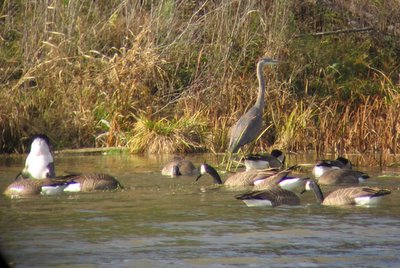 Mixed Company
Mixed CompanyThis would have been a better picture if I wasn't limited to digiscoping. Two Great Blue Heron flew into the this gathering of Canada Geese. They looked so beautiful with blue wings outstretched and legs reaching for a landing.
Today was just the warmup. Tommorow I hit Presquile!
Subscribe to:
Posts (Atom)















